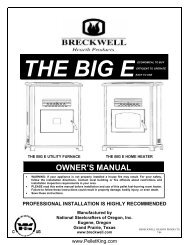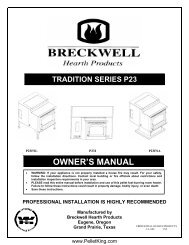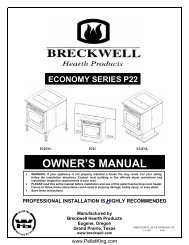INSTALLATION AND OPERATION MANUAL - Wood Pellet Stoves
INSTALLATION AND OPERATION MANUAL - Wood Pellet Stoves
INSTALLATION AND OPERATION MANUAL - Wood Pellet Stoves
You also want an ePaper? Increase the reach of your titles
YUMPU automatically turns print PDFs into web optimized ePapers that Google loves.
ROUTINE MAINTENANCE<br />
EXHAUST PASSAGES <strong>AND</strong> VENT PIPE (All Models)<br />
Inspect frequently and clean when necessary. Fly ash<br />
will accumulate at all bends in the exhaust system. Note:<br />
Large amounts of fly ash build-up will create a lack of<br />
combustion air. Removing the clean out tee cap on vertical<br />
installations will allow an inspection of the ash buildup<br />
in the clean out tee and will help you to decide how<br />
frequently more extensive cleaning must be performed.<br />
Clean-Out Tee Rain Cap<br />
Clean-Out Tee<br />
Remove cover, then<br />
remove ash<br />
Minimum Frequency of 1-2 months<br />
PAGE 28<br />
www.<strong>Pellet</strong>King.com<br />
DOOR ROPE GASKET (All Models)<br />
The condition of the rope gasket around the door and<br />
windows should be checked periodically and replaced or<br />
repaired if necessary. A one-inch strip of paper may be<br />
used to perform a test of the integrity of the door seal.<br />
Close the door on the paper in at least eight points (see<br />
illustration, “Door Rope Gasket”). It is normal to feel only<br />
a slight amount of friction. The door gasket does not<br />
need to be “tight” in all areas, since a small amount of<br />
leakage is not hazardous or detrimental to the performance<br />
of your stove.<br />
Door Rope Gasket<br />
(check seal at points indicated by arrows)<br />
Minimum Frequency of 3 months to 1 year<br />
Visually inspect gasket often. If it becomes frayed or<br />
damaged it should be replaced.<br />
CREOSOTE REMOVAL<br />
When wood is burned slowly, it produces tar and other<br />
organic vapors, which combine with expelled moisture to<br />
form creosote. The creosote vapors condense in the<br />
relatively cool chimney flue of a slow-burning fire. As a<br />
result, creosote residue accumulates on the flue lining.<br />
When ignited this creosote makes an extremely hot fire.<br />
The chimney connector and chimney should be inspected<br />
at least once every two months during the heating<br />
season to determine if a creosote buildup has occurred.<br />
If creosote has accumulated it should be removed to reduce<br />
the risk of a chimney fire.






